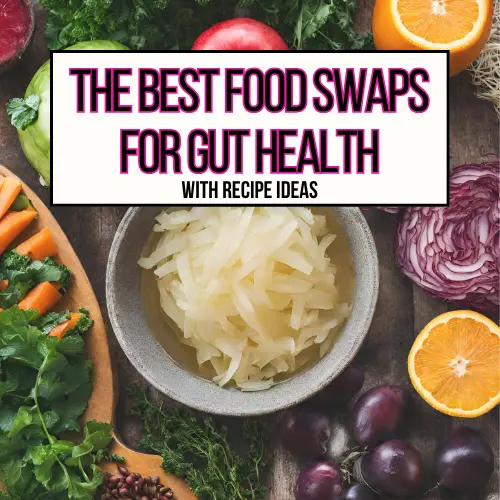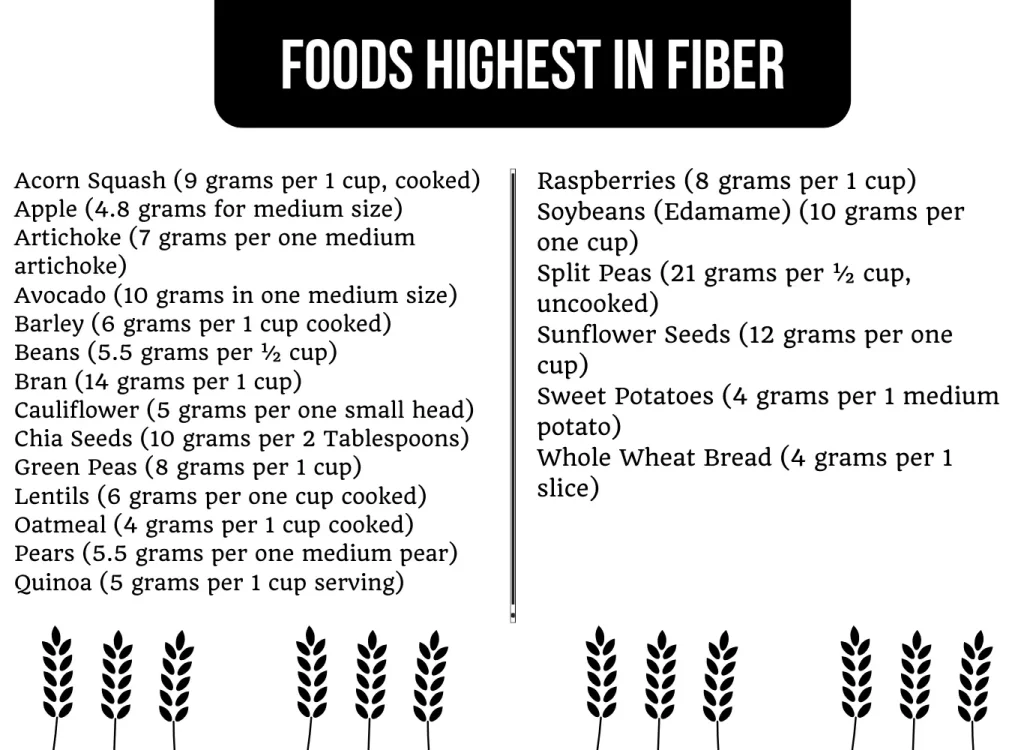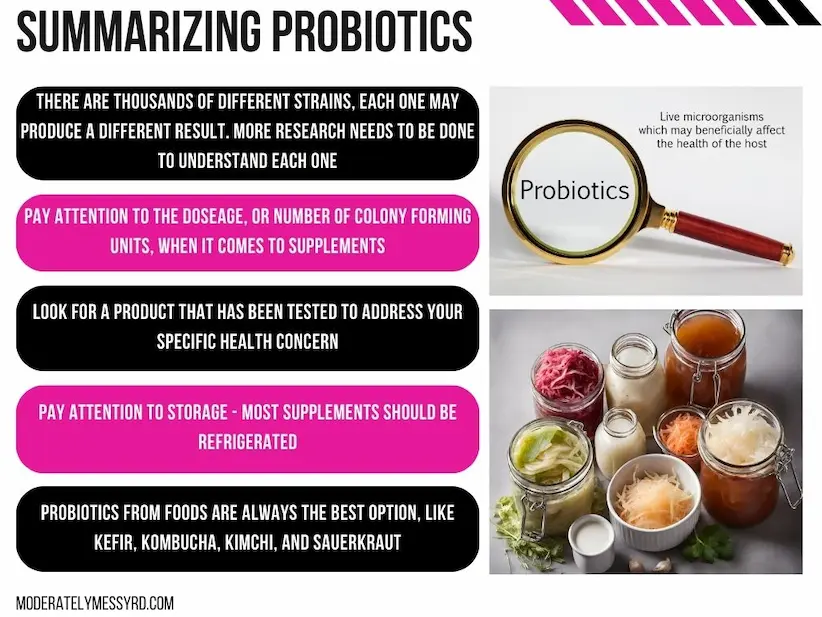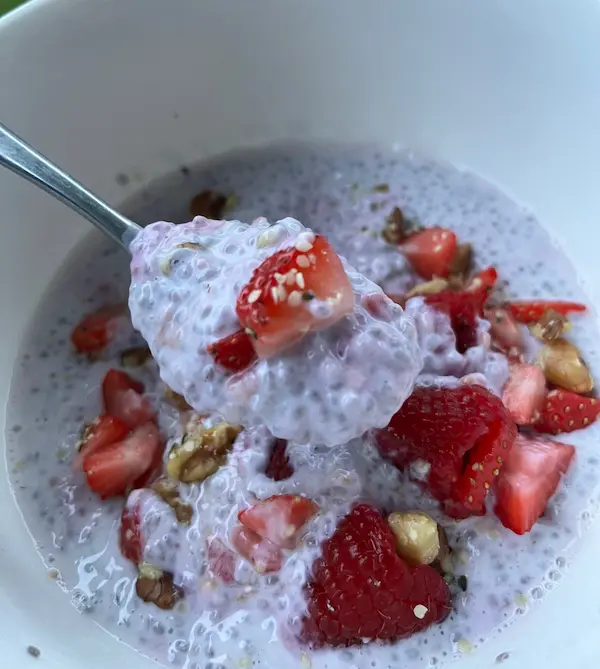A healthy gut microbiome can significantly impact our health both physically and mentally, and diet is a large piece of the very complex puzzle. This topic of “gut health” seems to be only rising in popularity with so many wondering – what do I need to eat for a healthier gut? This post explores what foods should be prioritized as well as evidence-based food swaps for gut health.
It might just be simply substituting some commons foods in your diet for better options. Let’s discuss, with recipe ideas included!

Understanding Gut Health
Our gut microbiome consists of trillions of microorganisms which can have an impact on our digestive system, immune function, mood, sleep, and cardiovascular health. Harvard describes it like a busy morning in New York City – sidewalks full of people, rushing to get somewhere.
It is all about finding a balance of these microorganisms so they can exist peacefully, as some are more beneficial than others. If there is a disruption of this balance, it can lead to an increased risk for infections and various diseases.
Each person has a unique microbiome that is determined by our DNA as early as gestation! As we get older, the composition of our gut is influenced by our diet, environment, illnesses, and even medications.
Foods That Promote a Healthier Gut Microbiome
Our diet plays a significant role in the composition, structure and function of our gut bacteria. It mostly comes down to increasing the consumption of fruits, vegetables, nuts, seeds and fermented foods.
Fiber
A recent study stated that dietary fiber is the key nutrient for maintaining the diversity of our gut microflora. Thus, a diet high in fiber increases the amount of microbiota as well as the type – which helps reduce the risk of inflammatory diseases such as obesity, diabetes, and IBD.
As you can see from the list below, foods high in fiber are typically fruits, vegetables, beans, legumes, nuts and whole grains. Screenshot this table so you can select more of these foods!

Fiber is broken down to create short chain fatty acids which have been shown to have anti-inflammatory, immunoregulatory, anti-obesity, anti-diabetes, anticancer, cardiovascular protective, hepatoprotective, and neuroprotective effects.
Read this article on How to Increase Your Fiber Intake for more RD-approved strategies.
Prebiotics
Prebiotics are a type of fiber that acts as food to feed the good bacteria in our gut. However, not all high fiber foods are considered prebiotics – they are specified as inulin, fructo-oligosaccharides (FOS), and galacto-oligosaccharides (GOS).
Garlic, onions, bananas, oats and apples are some of the best sources.
Probiotics
Probiotics are foods which contain live microorganisms which improve the “good bacteria” in our gut. Foods such as yogurt, and fermented foods like kefir, kimchi, miso, sauerkraut and kombucha have some probiotic activity.
Taking a probiotic supplement might provide some benefits if you know what strain and at what dose has been shown to improve your symptoms. Unfortunately, you can’t just choose any probiotic supplement and expect it to work for you.
There are thousands of strains and not all of them have been researched.
I recommend checking out this Clinical Guide to Probiotics in the U.S.A. for detailed strain and dose specific information for various medical conditions.

For a more in-depth breakdown, read my Ultimate Guide to Probiotics and Prebiotics.
Protein
The type and amount of protein we consume can affect the composition of our gut as well – but this is an area of research that needs to be further explored.
Some studies have found that consuming more plant-based protein sources positively impacts the composition of our gut bacteria, and overconsumption of animal protein sources may have the opposite effect.
Vitamin D
There is growing evidence that Vitamin D helps to regulate our gut microbiome and reduce inflammation. A 2020 study found that vitamin D supplementation increased microbial diversity in women deficient in this fat soluble vitamin.
Vitamin D deficiency is becoming more and more common, so try to prioritize foods high in vitamin D like salmon, trout, tuna, milk and fortified cereals.
The Best Food Swaps for Gut Health
Improve your gut composition with these simple food swaps for gut health- with some recipes included!
Milk –> Kefir

Kefir has the consistency of a drinkable yogurt, and can be substituted for milk in certain recipes. Kefir is considered a fermented food and contains a wider variety of live, active cultures as compared to yogurt.
It’s important to understand that cooking with kefir will destroy that good bacteria, therefore, it is best to use it in recipes like smoothies, overnight oats, as a base for salad dressing, and dips.
Get creative and think of ways you can incorporate it into your diet, like this delicious creamy strawberry gut health smoothie made with strawberry kefir.
Also try: Peach Pineapple Kefir Smoothie.
Sour Cream –> Greek Yogurt

Yogurt is the perfect substitute for sour cream, as both offer that tangy flavor. Greek yogurt is so versatile while also being high in protein.
Add it to Mexican-based recipes (like a taco dip, above), topping for a baked potato, dips, sauces, etc.
Here are some Greek yogurt recipes I have created. Again, be mindful that cooking with Greek yogurt will destroy the live, active cultures.
— Tofu Rice Bowl with Greek Yogurt Bang Bang Sauce
— Delicious Caramelized Apple Overnight Oats
— Apple Cinnamon Quinoa Breakfast Bowl
— High Protein Breakfast Burrito –> Greek yogurt added on top in replace of sour cream.
— Mini Strawberry Cheesecake Cups
— High Protein Taco Dip –> replace cottage cheese with Greek yogurt.
Vinegar –> Kombucha
Kombucha is one of the most studied fermented foods. While the taste can be a turn off for some people, it can be swapped for vinegar in dressings and sauces. You could also drink kombucha in replace of tea.
Recipes to Try:
— Light and Refreshing Kombucha Mocktails
— Chickpea Waldorf Salad with Creamy Kombucha Dressing (Flora and Vino)
— Maple Kombucha Salad Dressing (The Healthy Home Economist)
— Fig Kombucha Vinaigrette (The Roasted Root)
You could also use kombucha in a light and refreshing mocktail – give these recipes a try.

Rice –> Quinoa or Barley

Quinoa is a healthier swap for rice in just about any recipe. Quinoa has 5 grams of fiber per serving, as compared to <1 gram in most servings of rice.
I make it a point to cook with quinoa a few times a week, much to my husband’s dismay. It’s also considered a “complete” protein, containing all the essential amino acids.
Barley is another delicious option. It has a bit of a bite to it, which I love.
Some Delicious Quinoa & Barley Recipes:
— Mediterranean Grain Bowl (seen above)
— Easy Quinoa Salad (Two Peas and Their Pod)
— Turkey Quinoa Meatloaf (The Modern Proper)
— Barley with Mushrooms (Kalyns Kitchen)
— Barley Salad with Summer Vegetables (Lazy Cat Kitchen)
Pickles –> Fermented Pickles
Most grocery store pickles are pasteurized, so the good bacteria from fermentation is destroyed. The brand Olive My Pickle has actually been tested and found to have between 12 and 14 Billion CFUs (Colony Forming Units).
You could also try to make your own fermented pickles like these Fermented Pickles with Garlic and Dill (Feasting At Home).
Meat –> Beans and Legumes
Add more plant-based protein sources to your weekly meal rotation. Beans and legumes offer that additional fiber, while also offering many other benefits like reduced risk for diabetes and certain cancers.
As I mentioned earlier, there is growing research that overconsumption of meat may negatively impact our gut. Key word here is overconsumption.
White Bread –> Whole Wheat Bread
White bread has been processed to remove the bran, which is the part of a grain that contains the most fiber. Read different food labels and compare the fiber content in various brands of bread.
Flaxseeds –> Chia Seeds

Both flaxseeds and chia seeds are an excellent source of omega-3 fatty acids, but chia seeds reign supreme when it comes to fiber content. Just two tablespoons provides 10 grams of fiber!
Add these little seeds to smoothies, yogurt, pudding, oats, cereal, salads and more for a significant boost of fiber in your diet.
Recipes to Try:
— Chia Breakfast Bowl (pictured above)
— Banana Protein Smoothie
— Superfood Salad (Choosing Chia)
Tofu –> Tempeh
Tempeh is considered a fermented food when raw – but more importantly, it’s significantly higher in fiber than tofu!
One serving contains about 7 grams of fiber as compared to 1-2 grams in tofu.
Tempeh Recipes to Try:
— Easy Stir-Fried Tempeh (The Live In Kitchen)
— Sesame Tempeh Bowls (Budget Bytes)
Parmesan Cheese –> Nutritional Yeast
One serving of nutritional yeast provides 2 grams of fiber and 5 grams of protein. It has a cheese-like flavor, just like parmesan cheese for an easy add-on to pastas, vegetables, popcorn, soups and sauces.
Soy Sauce –> Miso/Miso Paste
Miso is another gut-friendly fermented food – are you noticing a trend here? It’s made from fermented soybean and has a umami-like flavor. Try a recipe like this Easy Miso Sauce (Eat Plant Based) and use it instead of soy sauce.
Recipes to Try:
— Miso-Ginger Dressing
— Miso Pesto (Okonomi Kitchen)
— Cold Miso Sesame Noodles
Butternut Squash –> Acorn Squash
Butternut squash is very popular in the fall and winter, but acorn squash is one of the highest fiber vegetables. It doesn’t quite get as much hype as butternut squash does, though – give it a try!
Strawberries –> Raspberries
When it comes to fiber, raspberries win over strawberries- hands down! One cup serving of raspberries contains 8 grams of fiber! Strawberries have less than 2 grams per one cup serving.
For More Information, Be Sure to Check Out These Posts:
— 8 Proven Strategies to Improve Gut Health
— Increasing Vitamin D Intake Through Foods {with Recipes}
— High Fiber Breakfast Ideas
— High Protein, High Fiber Meal Plans
aDDITIONAL tHOUGHTS
Our diet can significantly influence the composition of our gut microbiome, along with many other factors.
If you feel like your gut needs a refresh, I hope this post provided some ideas to try. Increasing fruit and vegetable consumption, in general, will lead to higher fiber intake.
Then, think about adding in some fermented foods which have been researched to help with a healthy gut! I didn’t mention sauerkraut or kimchi – but those are two more good options.
